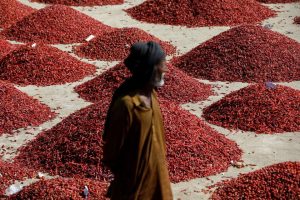In Asia’s capital of chillies, Kunri, heat, and flooding destroy crops.

Before the floods, scorching weather made it difficult to cultivate chili since it requires more temperate conditions.
Leman Raj, a farmer in his forties, searches through desiccated plants near Kunri, a town in southern Pakistan regarded as Asia’s chilli capital, for any of the brilliant red chillies in his totally devastated harvest that may have survived.
“After the heat had severely harmed my crops, the rains came, and the weather abruptly altered. Due to the recent heavy rains, we have seen significant crop losses, and this is what has happened to the chillies “He remarked while holding up several dead, diseased plants. “Every single chilli has rotted away.”
On February 24, 2022, a family gathers red chilli peppers near Kunri, Pakistan. After several years of extreme heat, Pakistan experienced devastating floods in August and September that have left the country’s chilli growers in a precarious position. Official estimates place the cost of the flood damage at $40 billion.
On February 24, 2022, a family gathers red chilli peppers near Kunri, Pakistan. REUTERS
Chilli producers are struggling to cope with the floods that wreaked havoc across Pakistan in August and September as a result of several years of extreme heat.
Farmers and scientists warn that in a nation that is primarily dependent on agriculture, the more extreme climate conditions are having a severe impact on rural economies, highlighting how vulnerable large portions of South Asia’s people are to shifting weather patterns.
Over $40 billion has already been projected as flood-related damages by officials.
On October 15, 2022, red chilli peppers that had been immersed in rainwater throughout the monsoon season in Kunri, Umerkot, Pakistan, were visible. After several years of extreme heat, Pakistan experienced devastating floods in August and September that have left the country’s chilli growers in a precarious position. Official estimates place the cost of the flood damage at $40 billion.
On October 15, 2022, red chilli peppers that had been immersed in rainwater throughout the monsoon season in Kunri, Umerkot, Pakistan, were visible. REUTERS
Pakistan is the fourth-largest producer of chillies in the world, with farms covering 150,000 acres (60,700 hectares) and generating 143,000 tonnes of chillies annually. Pakistan’s economy is based primarily on agriculture, making it susceptible to climate change.
Prior to the floods, hot weather made it more difficult to grow chilli, which requires more temperate weather.
“The heat was never this hot when I was a kid. We used to have a thriving crop, but since it has gotten so hot and rain has been so rare, our yields have decreased “explained Raj.
On October 15, 2022, a worker at the Mirch Mandi wholesale market in Kunri, Umerkot, Pakistan, takes a break on top of a pile of red chilli peppers.
On October 15, 2022, a worker at the Mirch Mandi wholesale market in Kunri, Umerkot, Pakistan, takes a break on top of a pile of red chilli peppers. REUTERS
According to Dr. Attaullah Khan, director of Pakistan’s Agricultural Research Council’s Arid Zone Research Centre, heatwaves during the previous three years had a negative impact on the growth of chilli crops in the region, leading to illnesses that curled their leaves and hindered their growth.
The recent floods present an entirely new set of difficulties.
“When it comes to climate change, how can we combat it? said he. “It is necessary to plan on a very large scale. It is necessary to restore four canals that once transported (extra) water to the ocean. We will have to make some extremely difficult decisions for that, but there is no other option.”
Many farmers said they have already had to make difficult choices.
On February 24, 2022, traders toil at the Mirch Mandi wholesale chilli market in Kunri, Umerkot, Pakistan.
On February 24, 2022, traders toil at the Mirch Mandi wholesale chilli market in Kunri, Umerkot, Pakistan. REUTERS
Faisal Gill, a farmer from Kunri, made the decision to sacrifice his cotton harvests to attempt to rescue chilli when water engulfed his land a few months ago.
Given that the cotton and chilli crops are grown side by side, Gill explained, “we built dikes around the cotton fields, put in pumps, and dug out tranches in the chilli crop to accumulate water and pump it out into the cotton crop fields.
On February 25, 2022, workers in Kunri, Umerkot, Pakistan, unload sacks of dried red chilli peppers at the Mirch Mandi wholesale market.
On February 25, 2022, workers in Kunri, Umerkot, Pakistan, unload sacks of dried red chilli peppers at the Mirch Mandi wholesale market. REUTERS
He claimed that although only 30% of his chilli crop was saved as a result of destroying his cotton, it was still better than nothing.
The impact may also be seen in Kunri’s thriving wholesale chilli market, Mirch Mandi. Although the market is littered with heaps of bright red chillies, vendors reported a significant decrease from prior years.
On March 18, 2022, near Kunri, Umerkot, Pakistan, a farmer plants saplings while holding hybrid red chilli pepper seeds in his palm. After several years of extreme heat, Pakistan experienced devastating floods in August and September that have left the country’s chilli growers in a precarious position. Official estimates place the cost of the flood damage at $40 billion.
On March 18, 2022, near Kunri, Umerkot, Pakistan, a farmer plants saplings while holding hybrid red chilli pepper seeds in his palm. REUTERS
According to vendor Raja Daim, there used to be 8,000 to 10,000 bags of chiles at the market at this time last year.
“It’s the first day of the week, and you can see that there are only about 2,000 bags here this year. It’ll be even less by tomorrow and the day after,” he said.










































